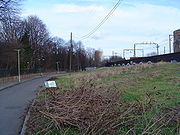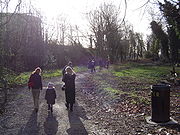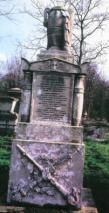
Tower Hamlets Cemetery
Encyclopedia

Cemetery
A cemetery is a place in which dead bodies and cremated remains are buried. The term "cemetery" implies that the land is specifically designated as a burying ground. Cemeteries in the Western world are where the final ceremonies of death are observed...
located in the East End of London
East End of London
The East End of London, also known simply as the East End, is the area of London, England, United Kingdom, east of the medieval walled City of London and north of the River Thames. Although not defined by universally accepted formal boundaries, the River Lea can be considered another boundary...
; its nearest tube station is Mile End
Mile End tube station
Mile End is a London Underground station in Tower Hamlets, East London, served by the Hammersmith & City, District and Central Lines. It is in Travelcard Zone 2.-History:...
. The cemetery opened in 1841 and closed for burials in 1966. It is now a nature reserve, and other land has been added to the park, including "Scrapyard Meadow". It was originally named The City of London and Tower Hamlets Cemetery but was called Bow Cemetery by locals.
Tower Hamlets Cemetery was formally consecrated by the Bishop of London
Bishop of London
The Bishop of London is the ordinary of the Church of England Diocese of London in the Province of Canterbury.The diocese covers 458 km² of 17 boroughs of Greater London north of the River Thames and a small part of the County of Surrey...
previous to its being opened for the reception of bodies.
Location
The Main Gate is on Southern Grove (on the crossing with Hamlets Way) in the BowBow, London
Bow is an area of London, England, United Kingdom in the London Borough of Tower Hamlets. It is a built-up, mostly residential district located east of Charing Cross, and is a part of the East End.-Bridges at Bowe:...
area of London
London
London is the capital city of :England and the :United Kingdom, the largest metropolitan area in the United Kingdom, and the largest urban zone in the European Union by most measures. Located on the River Thames, London has been a major settlement for two millennia, its history going back to its...
, E3 and is in the London Borough of Tower Hamlets
London Borough of Tower Hamlets
The London Borough of Tower Hamlets is a London borough to the east of the City of London and north of the River Thames. It is in the eastern part of London and covers much of the traditional East End. It also includes much of the redeveloped Docklands region of London, including West India Docks...
. There are also small gates on Hamlet Way and Cantrell Road.
History
Before the Victorian EraVictorian era
The Victorian era of British history was the period of Queen Victoria's reign from 20 June 1837 until her death on 22 January 1901. It was a long period of peace, prosperity, refined sensibilities and national self-confidence...
, all of London's dead were buried in small urban churchyards, which were so overcrowded and so close to where people lived, worked and worshipped that they were causing disease and ground water contamination.
An Act of Parliament
Act of Parliament
An Act of Parliament is a statute enacted as primary legislation by a national or sub-national parliament. In the Republic of Ireland the term Act of the Oireachtas is used, and in the United States the term Act of Congress is used.In Commonwealth countries, the term is used both in a narrow...
was passed which allowed joint-stock companies to purchase land and set up large cemeteries outside the boundaries of the City of London. There were seven great cemeteries (the "Magnificent Seven"
Magnificent Seven, London
The "Magnificent Seven" is an informal term applied to seven large cemeteries in London. They were established in the 19th century to alleviate overcrowding in existing parish burial grounds.-Background:...
) laid out about the same time (1832-1841). Highgate Cemetery
Highgate Cemetery
Highgate Cemetery is a cemetery located in north London, England. It is designated Grade I on the English Heritage Register of Parks and Gardens of Special Historic Interest in England. It is divided into two parts, named the East and West cemetery....
, where lots of famous dignitaries are buried, is the most well known: the others are Nunhead
Nunhead Cemetery
Nunhead Cemetery is one of the Magnificent Seven cemeteries in London, England. It is perhaps the least famous and celebrated of them.. The cemetery is located in the Nunhead area of southern London and was originally known as All Saints' Cemetery. Nunhead Cemetery was consecrated in 1840 and...
, West Norwood
West Norwood Cemetery
West Norwood Cemetery is a cemetery in West Norwood in London, England. It was also known as the South Metropolitan Cemetery.One of the first private landscaped cemeteries in London, it is one of the Magnificent Seven cemeteries of London, and is a site of major historical, architectural and...
, Kensal Green
Kensal Green Cemetery
Kensal Green Cemetery is a cemetery in Kensal Green, in the west of London, England. It was immortalised in the lines of G. K. Chesterton's poem The Rolling English Road from his book The Flying Inn: "For there is good news yet to hear and fine things to be seen; Before we go to Paradise by way of...
, Brompton
Brompton Cemetery
Brompton Cemetery is located near Earl's Court in South West London, England . It is managed by The Royal Parks and is one of the Magnificent Seven...
, Abney Park
Abney Park Cemetery
Abney Park in Stoke Newington, in the London Borough of Hackney, is a historic parkland originally laid out in the early 18th century by Lady Mary Abney and Dr. Isaac Watts, and the neighbouring Hartopp family. In 1840 it became a non-denominational garden cemetery, semi-public park arboretum, and...
.
The City of London and Tower Hamlets Cemetery Company was made up of eleven wealthy directors whose occupations reflect the industries of the day: corn merchant, merchant ship broker and ship owner, timber merchant, and Lord Mayor of the City of London. The company bought 27 acres (109,265 m²) of land and the cemetery was divided into a consecrated part for Anglican burials and an unconsecrated part for all other denominations.
Tower Hamlets Cemetery was very popular with people from the East End and by 1889 247,000 bodies had been interred (The cemetery remained open for another 77 years). In the first two years 60% of the burials were in public graves (i.e. those of poor people who could not afford a funeral) and by 1851 this had increased to 80%. Public graves were the property of the company and were used to bury those whose families could not afford to buy a plot. Several persons, entirely unrelated to each other, could be buried in the same grave within the space of a few weeks. There are stories of some graves being dug 40 feet deep and containing up to 30 bodies.

Greater London Council
The Greater London Council was the top-tier local government administrative body for Greater London from 1965 to 1986. It replaced the earlier London County Council which had covered a much smaller area...
(G.L.C.) bought the company for £100,000 under the G.L.C.(General Powers) Act and the ground was closed for burials. The intention was to create an open space for the public and relevant parts of the cemetery were freed from the effects of consecration
Consecration
Consecration is the solemn dedication to a special purpose or service, usually religious. The word "consecration" literally means "to associate with the sacred". Persons, places, or things can be consecrated, and the term is used in various ways by different groups...
. In October 1967 a further £125,000 was spent clearing the chapels and 0.68 acres (2,752 m²) of graves. Strong local opposition and problems of funding stopped the clearance.
The London Borough of Tower Hamlets
London Borough of Tower Hamlets
The London Borough of Tower Hamlets is a London borough to the east of the City of London and north of the River Thames. It is in the eastern part of London and covers much of the traditional East End. It also includes much of the redeveloped Docklands region of London, including West India Docks...
took over its ownership in 1986. It was declared a Local Nature Reserve
Local Nature Reserve
Local nature reserve or LNR is a designation for nature reserves in the United Kingdom. The designation has its origin in the recommendations of the Wild Life Conservation Special Committee which established the framework for nature conservation in the United Kingdom and suggested a national suite...
in May 2000 along with adjacent open land on Cantrell Road and Ackroyd Drive. It is also been designated as Metropolitan Open Land and a Conservation area. The high brick walls which surround it are on the national register of listed buildings as are 16 individual memorials.
Discussion on Re-Opening
An article in the East End Advertiser made it appear that Tower Hamlets Council planned to re-open the cemetery and make it a 21st century 'multi faith' burial site.(This was also picked up by the Daily Mail ). This created upset in the local community. At the following council meeting to discuss cemetery policy the council stated that it did not intend to re-open TH Cemetery Park as a cemetery.Tower Hamlets Cemetery Park
The Friends of Tower Hamlets Cemetery Park are a group of locals who came together in 1990 because they were concerned over the increasing neglect by successive owners. Their main objectives are to encourage greater use of this inner urban green space as a sanctuary for people and a place of biodiversity.The cemetery now resembles natural woodland, with many bird and insect species making it their home.
Local heroes

- Dr Rees Ralph Llewellyn — Performed autopsy on Mary Ann NicholsMary Ann NicholsMary Ann "Polly" Nichols was one of the Whitechapel murder victims. Her death has been attributed to the notorious unidentified serial killer Jack the Ripper, who is believed to have killed and mutilated five women in the Whitechapel area of London from late August to early November 1888.- Life...
, generally considered the first victim of Jack the RipperJack the Ripper"Jack the Ripper" is the best-known name given to an unidentified serial killer who was active in the largely impoverished areas in and around the Whitechapel district of London in 1888. The name originated in a letter, written by someone claiming to be the murderer, that was disseminated in the... - Alexander HurleyAlexander HurleyAlexander Hurley was best known for being Marie Lloyd's second husband, though he was also a successful and talented performer in his own right....
— Singer and Comedian, second husband of Marie LloydMarie LloydMatilda Alice Victoria Wood was an English music hall singer, best known as Marie Lloyd. Her ability to add lewdness to the most innocent of lyrics led to frequent clashes with the guardians of morality... - John "White Hat" Willis — Original owner of the Cutty SarkCutty SarkThe Cutty Sark is a clipper ship. Built in 1869, she served as a merchant vessel , and then as a training ship until being put on public display in 1954...
- Alfred Linnel — Trampled by a police horse during a demonstration in Trafalgar SquareTrafalgar SquareTrafalgar Square is a public space and tourist attraction in central London, England, United Kingdom. At its centre is Nelson's Column, which is guarded by four lion statues at its base. There are a number of statues and sculptures in the square, with one plinth displaying changing pieces of...
. Funeral was organised by Annie BesantAnnie BesantAnnie Besant was a prominent British Theosophist, women's rights activist, writer and orator and supporter of Irish and Indian self rule.She was married at 19 to Frank Besant but separated from him over religious differences. She then became a prominent speaker for the National Secular Society ...
and William MorrisWilliam MorrisWilliam Morris 24 March 18343 October 1896 was an English textile designer, artist, writer, and socialist associated with the Pre-Raphaelite Brotherhood and the English Arts and Crafts Movement... - Will CrooksWill CrooksWilliam Crooks was a noted trade unionist and politician from Poplar, London, and a member of the Fabian Society...
— Trade unionTrade unionA trade union, trades union or labor union is an organization of workers that have banded together to achieve common goals such as better working conditions. The trade union, through its leadership, bargains with the employer on behalf of union members and negotiates labour contracts with...
ist and first LabourLabour Party (UK)The Labour Party is a centre-left democratic socialist party in the United Kingdom. It surpassed the Liberal Party in general elections during the early 1920s, forming minority governments under Ramsay MacDonald in 1924 and 1929-1931. The party was in a wartime coalition from 1940 to 1945, after...
Mayor of PoplarPoplar, LondonPoplar is a historic, mainly residential area of the East End of London in the London Borough of Tower Hamlets. It is about east of Charing Cross. Historically a hamlet in the parish of Stepney, Middlesex, in 1817 Poplar became a civil parish. In 1855 the Poplar District of the Metropolis was... - Hannah Maria Purcell — Widow of William Purcell, carpenter of the HMS BountyHMS BountyHMS Bounty , famous as the scene of the Mutiny on the Bounty on 28 April 1789, was originally a three-masted cargo ship, the Bethia, purchased by the British Admiralty, then modified and commissioned as His Majesty's Armed Vessel the...
- Some victims of the Bethnal Green Disaster

